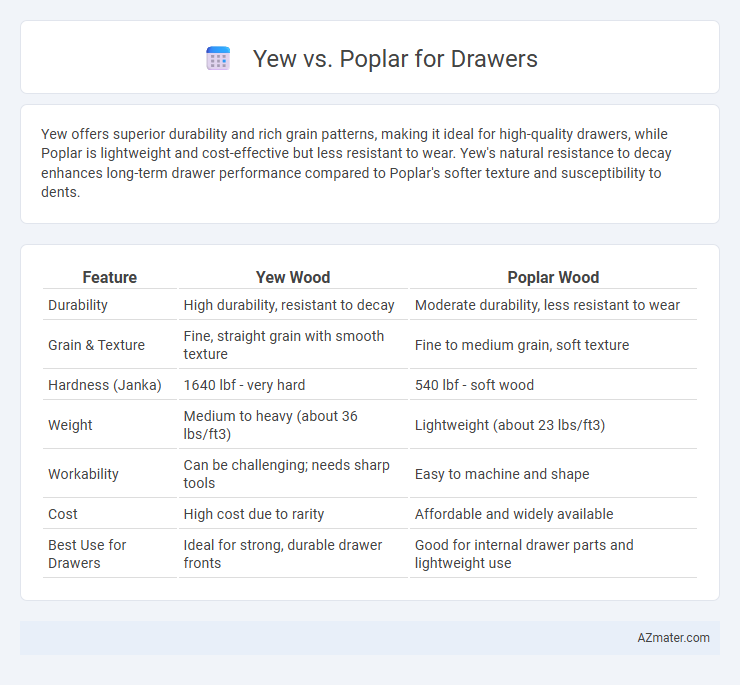Yew offers superior durability and rich grain patterns, making it ideal for high-quality drawers, while Poplar is lightweight and cost-effective but less resistant to wear. Yew's natural resistance to decay enhances long-term drawer performance compared to Poplar's softer texture and susceptibility to dents.
Table of Comparison
| Feature | Yew Wood | Poplar Wood |
|---|---|---|
| Durability | High durability, resistant to decay | Moderate durability, less resistant to wear |
| Grain & Texture | Fine, straight grain with smooth texture | Fine to medium grain, soft texture |
| Hardness (Janka) | 1640 lbf - very hard | 540 lbf - soft wood |
| Weight | Medium to heavy (about 36 lbs/ft3) | Lightweight (about 23 lbs/ft3) |
| Workability | Can be challenging; needs sharp tools | Easy to machine and shape |
| Cost | High cost due to rarity | Affordable and widely available |
| Best Use for Drawers | Ideal for strong, durable drawer fronts | Good for internal drawer parts and lightweight use |
Introduction to Yew and Poplar Wood
Yew wood is prized for its rich reddish-brown hue and fine grain, making it a durable and attractive choice for drawer construction. Poplar wood, known for its light color and uniform texture, offers easy workability and affordability, ideal for functional drawers with a smooth finish. Both woods provide unique aesthetic and structural qualities suited to different design preferences in cabinetry.
Botanical and Aesthetic Differences
Yew wood, from the Taxus genus, features dense grain and rich reddish-brown hues with intricate patterns, making it prized for high-quality drawer fronts that emphasize durability and fine textures. Poplar, belonging to the Populus genus, has a lighter, more uniform pale green to creamy color with a softer, straight grain, offering a smooth surface ideal for painted or stained drawers requiring a budget-friendly option. The botanical differences influence their workability and finish, with yew's resinous, hard structure contrasting poplar's porous, more pliable nature, directly affecting the drawer's longevity and visual appeal.
Durability and Strength Comparison
Yew wood offers superior durability and strength compared to poplar, making it ideal for drawers subjected to frequent use and heavy loads. The dense grain structure of yew provides excellent resistance to wear and impacts, while poplar's softer, more pliable nature can lead to faster denting and deformation over time. For long-lasting drawer construction, yew ensures enhanced structural integrity and longevity.
Workability for Drawer Construction
Yew wood offers superior workability for drawer construction due to its dense, fine-grained texture that allows for smooth cutting, shaping, and sanding, resulting in precise joints and a polished finish. Poplar, while softer and easier to machine, tends to splinter and may require more careful handling to avoid damage during assembly. The durability of yew combined with its workability makes it a preferred choice for long-lasting, finely crafted drawers, whereas poplar is better suited for budget-friendly projects requiring quick, efficient fabrication.
Appearance and Grain Patterns
Yew wood features a rich, warm yellow to reddish-brown color with distinctive, fine grain patterns often highlighted by occasional dark streaks, creating an attractive contrast ideal for elegant drawer fronts. Poplar exhibits a lighter, more uniform greenish or pale yellow hue with subtle, straight grain lines that give drawers a clean and simple appearance suited for modern or painted finishes. Yew's unique grain complexity adds visual interest and depth, whereas poplar offers a smooth, consistent texture that enhances durability without drawing attention to wood variations.
Weight and Density Considerations
Yew wood, with a density of approximately 0.46 g/cm3, is lighter yet strong, making it suitable for drawer construction where moderate weight is desired. Poplar, denser at around 0.41 to 0.48 g/cm3, is slightly heavier but offers good stability and resistance to warping in drawers. Choosing between Yew and Poplar hinges on balancing weight preferences and the required durability for the drawer's function.
Cost and Availability
Yew wood is generally more expensive and less readily available than poplar, as it is valued for its fine grain and distinct color, making it a premium choice for drawer construction. Poplar, being a widely available hardwood, offers a cost-effective alternative with decent durability and a lighter color that takes paint well, which is ideal for budget-friendly projects. The choice between yew and poplar often depends on balancing budget constraints with the desired aesthetic and material performance for drawers.
Environmental Impact and Sustainability
Yew wood, known for its durability and slow growth, has a higher environmental impact due to longer harvesting cycles and limited availability, making it less sustainable for drawer construction compared to Poplar. Poplar, a fast-growing hardwood, offers a more sustainable option with its rapid regeneration rate and lower ecological footprint, supporting responsible forestry practices. Choosing Poplar helps reduce deforestation and promotes resource efficiency in drawer manufacturing.
Best Use Cases for Yew and Poplar Drawers
Yew wood is ideal for drawer construction due to its natural durability, fine grain, and resistance to warping, making it perfect for heirloom-quality or custom furniture where aesthetics and longevity are paramount. Poplar, being a lightweight and budget-friendly hardwood with a smooth texture and ease of painting, suits functional drawers in kitchens, workshops, or painted cabinetry where cost-efficiency and versatility are prioritized. Choosing yew benefits premium pieces requiring strength and visual appeal, while poplar excels in practical, everyday use with adaptable finishes.
Conclusion: Which Wood Is Better for Drawers?
Yew wood offers superior durability and a rich, fine grain ideal for high-quality drawer construction, while poplar provides a more affordable, lightweight option with easier workability and a consistent texture. For drawers requiring long-term strength and a luxurious finish, yew is the better choice, whereas poplar suits budget-friendly projects with quick assembly needs. Ultimately, yew excels in durability and aesthetic appeal, making it the preferred wood for premium drawer craftsmanship.

Infographic: Yew vs Poplar for Drawer
 azmater.com
azmater.com